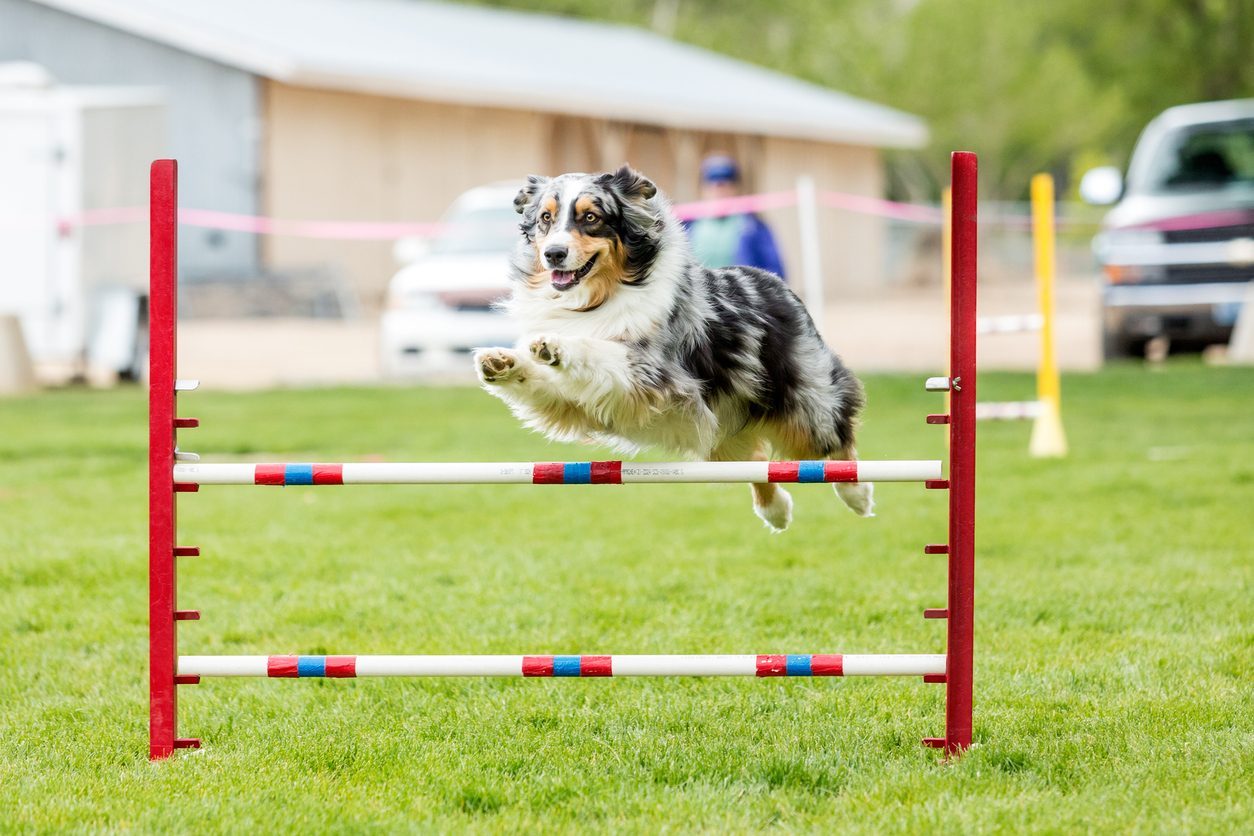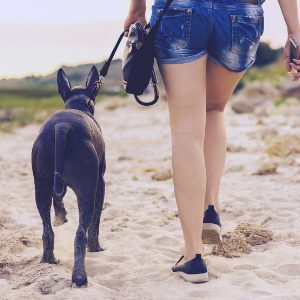 Guest article by:
Guest article by:
Matthew Brunke, DVM, CCRP, CVPP, CVA
Diplomate, American College of Veterinary Sports Medicine and Rehabilitation
Published 6/2020
Why you should incorporate warm-ups and cool-downs into your dog’s exercise routine
“That’s one small step for a man, one giant leap for mankind.” – Neil Armstrong, Moon, 1969
As veterinarians, owners, and handlers, we want to achieve the moon with our dogs. Whether it is agility, conformation, rally, flyball, playing in the yard, or going for a walk or run, we want the best for our dogs, and we want them to do it in good health and without injury.
While the “giant leap” may come after months of training, it does not happen without the small steps, both before and after it. Those steps include proper nutrition, baseline veterinary visits, and countless hours working with your dog. An often “missed step” are appropriate warm-up and cool-down exercises, during training, competition, or activity in general. These missed steps can put your dog at risk for a poor run, or worse, an injury. We wanted to review the importance of these exercises and provide a solid footing for you and your dog to achieve the moon and the stars.
Canine athletes and dogs with arthritis
While this article will discuss specific warm-up and cool-down recommendations for dogs engaged in canine sports such as agility or fly ball, the principles still very much apply to dogs that are not “canine athletes.” Dogs that have arthritis should actually not engage in high impact sports such as agility or fly ball, but they should remain active. Arthritis is often accompanied by tight, weak, and sore muscles, so the warm-up and cool-down are extremely important for dogs with arthritis in order to prevent further injury.
I get it- warming up and cooling down can seem like a drag. As a sports medicine and rehab veterinarian, this is a common objection I hear from my clients. Warming up and cooling down requires additional time and this might seem like “just one more thing” to try to fit into a tight schedule. But, instead of thinking how much time it costs to fit it in, consider instead what it might cost you – and your dog – to not to.
While we don’t have a ton of research for our companion dogs on this subject, we can look at both human research and canine athletic competitions as a comparison.
What is agility?
 Agility is an explosive sport that includes a short duration with high muscle activity, very similar to the sort of exercise a human sprinter or hurdler does. It is well accepted in human sports medicine that warming up prior to exercise is vital for maintaining maximum performance, both at the immediate event and into the future. For this reason, warm-up exercises are extremely important and often overlooked in our canine athletes.
Agility is an explosive sport that includes a short duration with high muscle activity, very similar to the sort of exercise a human sprinter or hurdler does. It is well accepted in human sports medicine that warming up prior to exercise is vital for maintaining maximum performance, both at the immediate event and into the future. For this reason, warm-up exercises are extremely important and often overlooked in our canine athletes.
Warm-up exercises can also decrease the risk and amount of injuries. In a human study done at the Oslo Sports Trauma Centre, research showed a 50% decrease in injuries when sports event-specific warm-up exercises were done. There is very little research in this area for the canine athlete, but there is a lot that we can cross over from the human field to help us build a better, and longer, working life for sports dogs.
Let’s look specifically at the sport-specific considerations for agility and flyball that make warm-up exercises critical.
Agility is a demanding athletic activity, requiring dogs to be mobile enough to withstand tight turns, rapid acceleration and deceleration, and difficult contact and weave entries. Approximately 33% of agility dogs will have an injury in their career that will make them stop competing and training for a period of time, often to the shoulder assembly and back, indicating the need to pay special attention to preparing these areas for efficient and coordinated movement. Given that agility requires movements in all three planes of motion, it’s important to consider a warm-up routine that will support all these movements that we expect from the dog when they enter the ring.
The sport of flyball is very fast and intense and requires a great deal of physical exertion in a short period of time. Dogs need exceptional explosive speed to drive down the line of four jumps, retrieve the ball and come barreling back over the four jumps while being judged for speed/time. Flyball dogs are susceptible to chronic repetitive stress injuries in their shoulder and lower body from the force required to propel off the box, as well as carpal injuries and jammed toes. Dogs not only need to be warmed up enough to access a full range of motion through their shoulders and rear, but also to be able to do so explosively.
Why are warm-ups so important?
Warming up leads to an elevation in body temperature, which in turn leads to an increase in muscle temperature. This increase in muscle temperature causes an increase in muscle metabolism and muscle fiber conduction velocity; meaning that signals telling muscles what to do travel faster in a warm muscle. This increase in muscle warmth can have a big effect on performance. A 1% increase in muscle temperature can lead to a 2 to 5 % increase in exercise performance when related back to power output, which correlates to speed.
In human research, it has also been shown that there is greater muscle contractile performance following a warm-up period with active prior muscle contracture. Human studies have also shown that with muscle warming contraction rates of Type 2 muscle fibers are far greater than those of Type 1 muscle fibers when exercise levels are high. This is particularly relevant in dogs as the main locomotor muscles are Type 2 muscle fibers … hence more explosive power and movement.
What do warm-ups look like?
There are two types of warm-ups, passive and active.
Passive warm-ups allow for an increase in body temperature and therefore an increase in muscle temperature without depleting stores of the energy needed for muscle contracture as happens with active warm-ups. It is generally accepted that passive warm-ups alone are not a good method to prepare for a sporting event.
Studies have shown that overstretching before an event can actually decrease muscle function. It has also been shown that it doesn’t decrease the rate of injury.
However many of the passive warm-up heat maintenance techniques can be applied to the transition phase between warming up and competing, so that muscle temperature elevation is maintained.
Active warm-ups induce metabolic change and aim to induce aerobic energy production for the muscles. This can take 120 seconds to start, so if not warmed up properly a canine athlete may not even be using its main muscle energy source before the event is over. So active warm-ups are actually priming the muscle for function and allowing the muscle to lengthen to full functional range of motion before a competition.
The effectiveness of the active warm-up is related to its intensity and the duration of the physical tasks. Human studies have shown that as well as moderate exercise to elevate temperature, the warm-up must include one event pace exercise for 25 percent duration of the whole event.
Agility Events are short duration with high output. In similar human events, Post-Activation Potential (PAP) has been found to be critical for full performance. These studies show that muscular performance is acutely enhanced when preceded by a near-maximal neuromuscular activation exercise. In agility dogs, this means incorporating a run and jump into the warm-up exercises.
How to Warm Up:
 For any sports dog, there are 2 main ways of looking at warm-ups.
For any sports dog, there are 2 main ways of looking at warm-ups.
There are general warm-ups that all dogs should do, and then there are specific warm-up exercises for a dog with a pre-existing injury.
The first part of warming up is cardio exercise. This increases the heart rate and blood flow and therefore the body and muscle temperature. Here is a cardio warm-up:
- Initially a walk or trot for 5 to 10 minutes.
- At a moderate exercise level, it takes about 10 minutes for the muscle temperature to raise and reach equilibrium.
- Low Tugs – toy must be low to the ground so as not to hyperextend the neck. This actively engages muscles in the forelimbs, spinal column, and hind limbs.
- Sidestep for 30 feet -This is a good proprioception exercise to activate awareness as well as engaging shoulder and hip abductors and abductors.
- Low level jumps – Only 4 or 5. These activate the PAP system discussed earlier.
- Left and Right Pivots for a minute or so.
The next part of warming up is active stretching, this is done after the cardio portion.
- Play bow: Allows for spinal extension and forelimb stretch.
- Cookie stretches: Active Range of Motion Stretches of the whole body.
After this, you can add specific movements targeting specific limbs if there is a pre-existing injury.
Visualization and preparatory arousal have been shown to enhance exercise performance in people. Although we can’t do visualization exercises with our sporting dogs, we can do preparatory arousal. In some dogs, this is as simple as doing the warm-up exercises, and they automatically are stimulated by what they know will follow. In other dogs, the effect of walking around other dogs competing cannot be discounted.
However, all of these gains are affected by the transition phase from warm-up to competition that we have now entered.
Before competition
Human studies have shown that up to 10 minutes is optimal from warm-up to the competition. This is not always possible, so mixtures of active and passive techniques are used.
Simply keep walking and moving for this time period. Do not stop and allow the dog to just sit and wait. Also, coats are a good way of helping to maintain core temperature. A different thickness coat can be used depending on the time of year, and in cold climates a heated coat can be used. Do not think the dogs’ coat is enough to maintain this elevated core temperature. Again human studies have shown an effective prolonging of the transition period to 30 minutes by the use of passive warming aids and an increase in performance of up to 9 percent.
If your dog is competing in a sport that has multiple runs over the course of the day (e.g. 4-5 agility runs/a day), be sure to warm them up before each run. The benefits of the first warm-up in the morning will not carry over to all the runs later in the day.
If you happen to have two runs that are back to back, you might consider a shorter warm-up for their second run if the dog is already warmed up, their heart rate is elevated, and they have not been crated.
Taking your pet out for a run with you? Start off by letting them stretch, and walk a block or two (gives them a chance to urinate/defecate). Then get into your run.
Playing fetch in the yard instead? Start with short throws of the ball/frisbee and give them a few breaks in between. Then gradually increase those distances.
Hopefully, you have timed your warm-up perfectly, and you and your dog are ready for activity. Once the run is over, it is just as important to cool down your dog appropriately as well.
Cooldowns: What Does Cooling Down Do?
Not only is this physically beneficial but it is also mentally important for your dog as it allows them to calm down and unwind. It can also be very discouraging for our dogs if we simply put them back in their crates and ignore them. The cooldown serves three main purposes:
- It provides us some focused time to praise and bond with our dogs after working together
- It can help cue them to relax and settle down
- It helps restore shortened muscles back to their original length.
The cooldown also assists with stretching muscles, removing the lactic acid build-up (Calleja-González et al., 2015), and reducing the chances of chronically tight muscles. The lactic acid build-up is a result of normal strenuous activity and contributes to early muscle soreness and fatigue (Han, Kim, Yang, & Sung, 2014). Over time, shortened muscles will create less power and can potentially cause uneven pressures on the articular cartilage but also lead to a variety of compensatory issues elsewhere in neighboring muscles.
Additionally, the cooldown will help your dog’s heart rate return to its resting rate but will also cause a constriction in the blood vessels in the dog’s legs and re-distribute this blood back to the body. This is important because it will
- reduce the potential of blood pooling in the dog’s extremities
- prevent any post-exercise dizziness that can occur when exercise is stopped (Zink, 2008).
Cooldown Exercises:
Compared to warm-up exercises, cool down exercises are straight forward.
- A 5 to 10-minute walk.
- Passive stretching to the full range of the limbs with a 30-second hold.
- Active forelimb and hind limb stretch.
Conclusion
Okay, I know- you still might not be convinced that your dog really needs to warm up. After all, you’ve seen them go from zero to 60 in the backyard when it comes to chasing squirrels without a warm-up. The truth is our dogs can just as easily injure themselves by sprinting across the backyard without a warm-up as they can in the performance ring. We can’t control everything our dogs do, but what we can control, we should take advantage of by ensuring their bodies are prepared for the activities at hand.
References
1. C McIntyre (2018). Warm up and Cool Down of the Canine Athlete: An Evidenced Based Approach to Improving Performance and Preventing Injury – E-Book Publication
2. Courtney J. McGowan, David B. Pyne, Kevin G. Thompson, Ben Rattray. Warm-Up Strategies for Sport and Exercise: Mechanisms and Applications, Sports Med (2015) 45:1523–1546.
3. Pearce AJ, Rowe GS, Whyte DG. Neural conduction and excitability following a simple warm up. J Sci Med Sport. 2012;15(2):164
4. Mellalieu S, Hanton S. Advances in applied sport psychology: a review. Abingdon, UK: Routledge; 2008.
5. Han, J., Kim, M-J, Yang, H-J., Lee, Y-J, & Sung, Y-H. (2014). Effects of therapeutic massage on gait and pain after delayed onset muscle soreness. Journal of Exercise Rehabilitation, 10(2), 136-140.
6. Calleja-González J., Terrados, N., Mielgo-Ayuso, J., Delextrat, A., Jukic, I., Vaquera, A., & Ostojic, S.M. (2015). Evidence-based post-exercise recovery strategies in basketball. The Physician and Sportsmedicine. DOI: 10.1080/00913847.2016.1102033
7. Olsen O, Sjohaug M, van Beekvelt M, Mork PJ, The effect of warm-up and cool-down exercise on delayed onset muscle soreness in the quadriceps muscle: a randomized controlled trial. J Hum Kinet 2012 Dec;35:59-68. doi: 10.2478/v10078-012-0079-4. Epub 2012 Dec 30.
8. Zink CM and Van Dyke JB. Canine Sports Medicine and Rehabilitation. 2013. John Wiley and Sons. ISBN: 978-0813812168.

